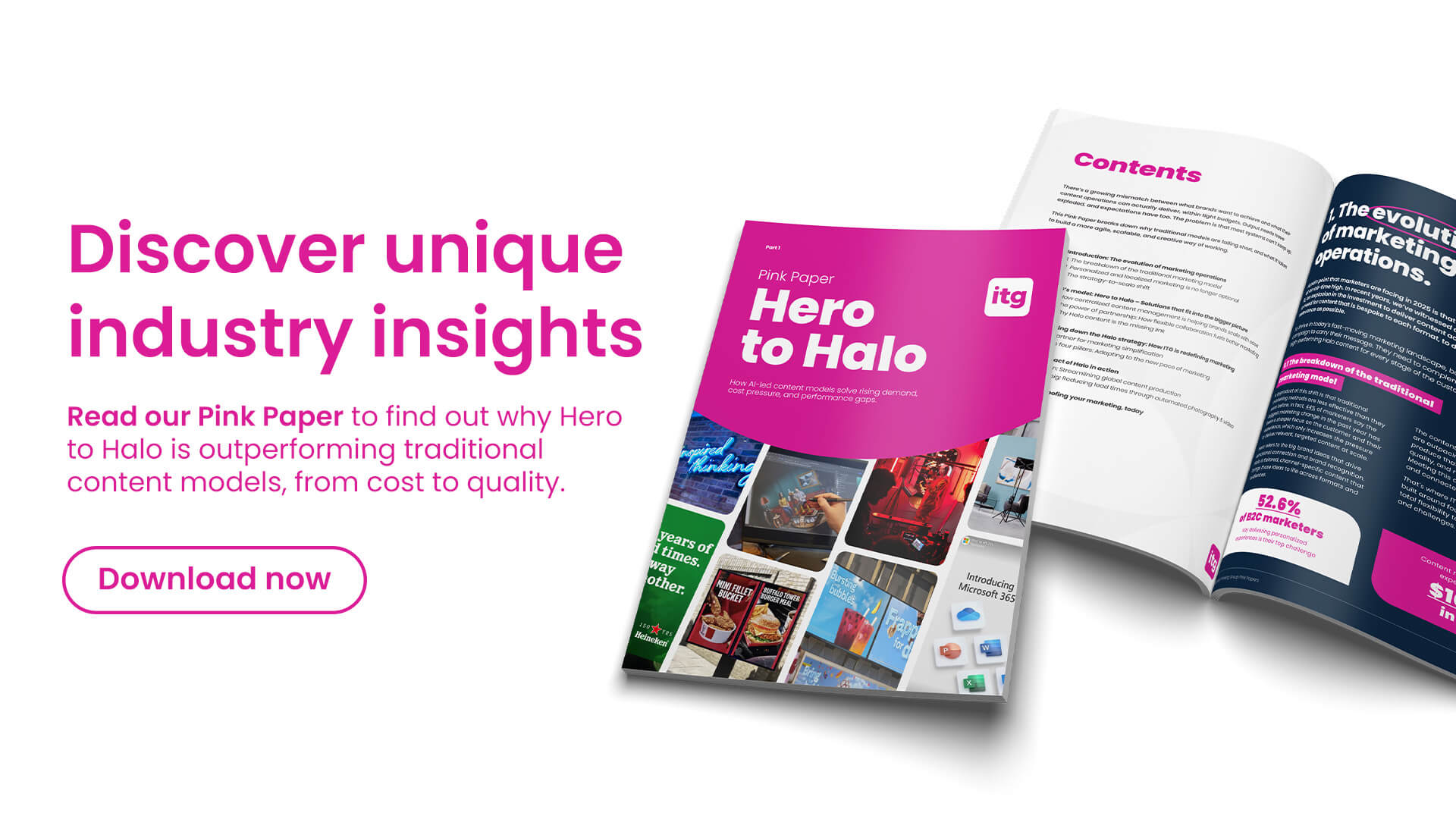Personalized and localized marketing has moved from “nice to have” to business-critical. According to recent research, 71% of consumers expect brands to deliver personalized experiences. When brands fail to meet this demand, 76% of consumers report feeling frustrated, risking lost trust and loyalty.
This will often result in customers tuning out and brands losing their competitive edge as a consequence.
At ITG, we see this as a fundamental shift that’s reshaping how brands engage their audiences and grow revenue. The good news is that brands that deliver targeted, relevant content can both mitigate risk and unlock significant growth.
Our latest Pink Paper explores these trends in detail, outlining how a strategic rethink — powered by AI and automation — can transform content delivery and customer experience.
The changing baseline: What consumers really expect
The baseline for consumer expectations has changed dramatically. No longer satisfied with generic messaging, today’s audiences demand personalized, relevant content that reflects their preferences, behaviors, and local context.
Traditional marketing models struggle here. They’re costly, slow, and often inefficient, lacking the agility to meet these rising demands. For brands, this creates a strategic challenge: how to create targeted content at scale without ballooning costs or losing creative impact.
Research backs this up. Companies delivering effective targeted content see revenue lifts of 10-15%, while those leading the charge generate up to 40% more revenue than peers. This demonstrates that personalized marketing is a clear growth driver.
Why the brand-agency disconnect puts growth at risk
Despite agencies reporting 76% confidence in their delivery, only 39% of brands say they are satisfied with agency partnerships. This disconnect means many brands aren’t getting the speed, flexibility, or precision required in today’s fast-moving markets.
Procurement and marketing teams face mounting pressure: marketing needs to produce campaigns quickly and at scale, while procurement must manage costs and supplier performance. Without alignment, campaigns slow down, costs rise, and value is lost.
At ITG, we see this as a call for a joined-up approach; one that integrates marketing, procurement, and agency capabilities around shared goals, data, and workflows. This alignment is critical to unlocking efficiency and delivering consistently high-quality, personalized content.
The strategy-to-scale shift: How AI and automation enable growth
The answer lies in embracing a strategy-to-scale shift enabled by AI-driven automation and smarter workflows. Brands must move beyond manual, time-consuming content production to a model that balances speed and scale with creative quality.
More than a third of B2C marketers report AI implementation as a top priority for 2025, reflecting its growing role in marketing transformation. AI enables brands to automate asset creation, customize content at scale, and optimize multichannel distribution — without sacrificing brand consistency or creative impact.
ITG’s Halo Strategy: A new framework for efficient, targeted content
At ITG, our Halo Strategy delivers this shift in practice. It’s designed to help brands move from sporadic “hero” campaigns to an integrated ecosystem that continuously delivers personalized, targeted Halo content that nurtures audiences across every stage of the funnel.
- Hero is the big idea or creative concept that drives brand recognition and builds awareness.
- Halo content is the timely, relevant, automated messaging tailored to segments, channels, and behaviours, ensuring hero ideas land with genuine performance and impact.
Combining AI-driven automation with expert creative input, this approach drives down production costs, increases speed to market, and improves ROI.
For example, with Heineken, our Halo Strategy reduced production costs by 40% while supporting high-quality, consistent content across global markets.
How can you build an efficient, effective operational model?
Based on our experience and insights from the Pink Paper, here’s how brands can start building this capability:
1. Map and audit your content workflows. Identify bottlenecks and inefficiencies slowing your ability to respond to market needs.
2. Invest in AI and automation technologies that streamline content creation, personalization, and delivery — focused on your specific challenges.
3. Align marketing, procurement, and creative teams around shared KPIs like speed to market, cost efficiency, and content performance.
4. Build an integrated multichannel content calendar balancing high-impact hero campaigns with ongoing halo activations.
5. Use data and analytics continuously to optimize targeting, personalization, and messaging effectiveness.
Why this matters for your growth
Brands that master personalized and localized marketing unlock growth through improved customer engagement, trust, and loyalty. Adopting an AI-enabled model can reduce content production costs, accelerate campaign delivery, and scale creative efforts without compromising quality.
ITG’s Halo Strategy not only helps brands meet these demands but does so in a way that integrates seamlessly with existing teams and tech stacks. Our unique blend of award-winning technology and agency expertise enables brands to build marketing ecosystems that drive operational efficiency and growth.
Looking ahead: Collaboration is key
The future of marketing is one of partnership — between marketing, procurement, and creative teams. Economic pressure and rapid technological change demand that businesses break down silos and adopt integrated approaches.
At ITG, we’re committed to helping brands navigate this new landscape. Our latest Pink Paper offers practical insights and proven frameworks for delivering personalized, localized marketing that drives measurable business outcomes.

